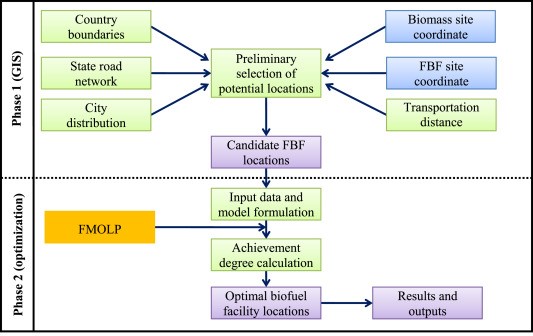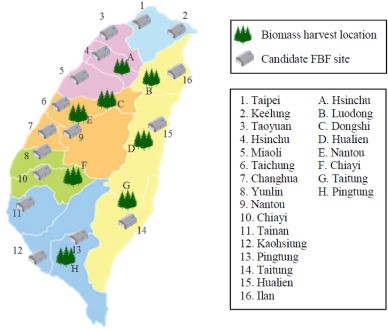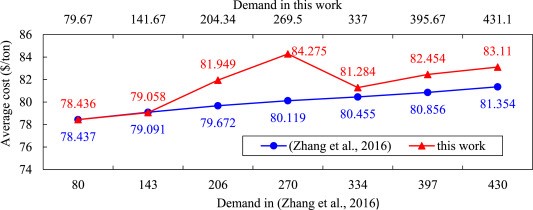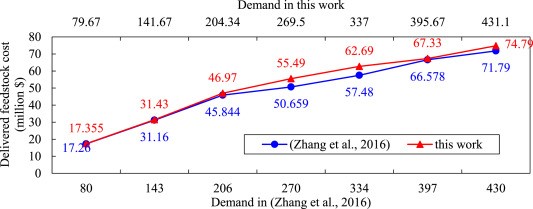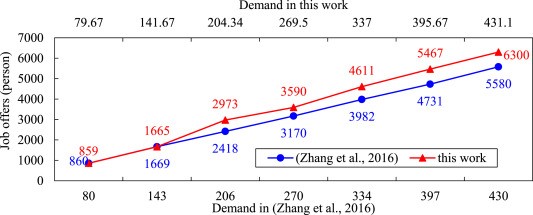生態農業:農業地景生態監測及復育【森林學系/柳婉郁特聘教授】
| 論文篇名 | 英文:Forest Biomass-to-biofuel Factory Location Problem with Multiple Objectives Considering Environmental Uncertainties and Social Enterprises 中文:考慮多目標與環境不確定之森林生質能源廠位址之研究 |
| 期刊名稱 | JOURNAL OF CLEANER PRODUCTION |
| 發表年份,卷數,起迄頁數 | 2020, 262 (20), 121327 |
| 作者 | Lin, Chun-Cheng; Kang, Jia-Rong; Huang, Guan-Lin; Liu, Wan-Yu(柳婉郁)* |
| DOI | 10.1016/j.jclepro.2020.121327 |
| 中文摘要 | 森林生質能具有產量大,可再生和清潔燃燒的優點。但是,大多數相關的文獻在最小化成本或污染的目標上,很少涉及社會方面。社會企業提供的商業模式可以應對社會或環境問題,例如,在貧困地區提供就業機會。因此,這研究考慮了具有多個目標的森林燃料工廠選址問題中並考慮社會企業和環境不確定性。除了成本和碳排放量最小,還考慮社會企業角度最大化工作機會的目標。另外,基於模糊理論,研究考慮環境不確定性:包括不確定的庫存天數,不確定的工作機會,不確定的生質能生產量及化石燃料價格波動不確定等。我們研究也利用GIS來決定森林生質能和工廠候選位置,透過模糊多目標線性規劃解決問題。我們比較此方法與先前方法之間的差異,並分析了影響結果關鍵因素。模擬結果指出,當每年生物燃料總需求量超過2億升時,與僅考慮成本最小化方法相比,本研究方法所決定的工廠位址可多提供16%的工作機會。 |
| 英文摘要 | Forest biomass energy enjoys merit of large production, renewability, and clean combustion. However, most related works focused on only the objective of minimization of cost or pollution, but seldom on the social aspect. Social enterprise provides business models that cope with social or environmental problems, e.g., offering employment opportunities in disadvantaged areas. Therefore, this work considers social enterprises and environmental uncertainties in a forest biomass-to-biofuel factory location problem with multiple objectives, which determines whether to open forest biomass-to-biofuel factories at their potential locations to meet the energy demand and other practical constraints. Aside from minimization of cost and carbon emissions, the concerned problem additionally considers the objective of maximizing the job offers provided by opening factories from the social enterprise aspect. Additionally, based on the fuzzy theory, this problem includes the following environmental uncertainties: uncertain number of inventory days, uncertain job offers per unit of surplus factory scale, uncertain biomass production amount, and uncertain biofuel demand due to the price fluctuation of fossil fuels. This work employs the GIS to determine candidate locations of acquiring forest biomass and opening factories, and then solves the problem by fuzzy multi-objective linear programming. Through simulation, we observe the conflict among objectives, compare the differences between the proposed method and previous methods, and analyze the key factors that affect practical implementation. Simulation results show that when the total biofuel demand exceeds 200 million liters per year, the proposed method provides 16% more job offers than the previous method that focused on only cost minimization. |
